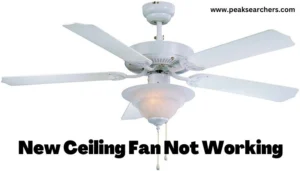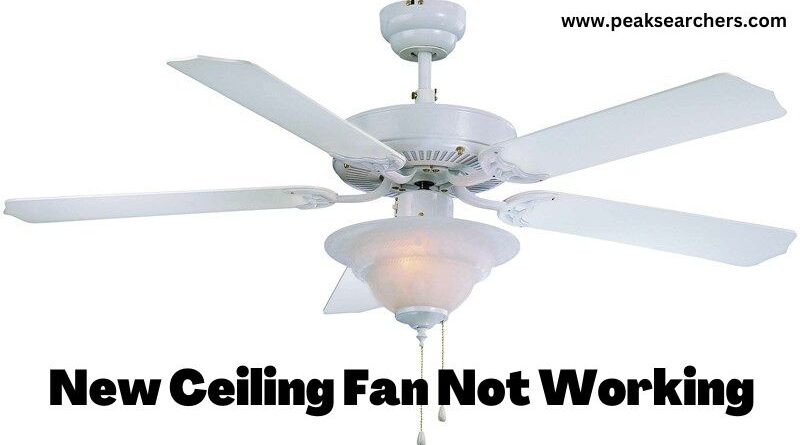Fix Ceiling Fan Not Working? An Ultimate Guide
If your brand-new ceiling fan isn’t working, you may be wondering what could possibly be wrong with it. Especially if you just spent hundreds of dollars on it.
Take heart! There are many reasons why a new ceiling fan may not be working. Most of them are relatively simple to fix.
If you can’t find the answer yourself, here’s an ultimate guide to why your new ceiling fan isn’t working and how to fix it. These fixes are tried by me personally as I had also faced this problem beforehand. I got the problem solved by trying these fixes.
I have also included some safety tips to keep in mind when operating your ceiling fan so that you stay safe while saving money on your energy bill!

Identify the Problem
The main cause of ceiling fans not working is usually due to one of two problems: The first is a simple dead-fan situation. It’s easy enough to determine if your fan has died by simply switching it on and waiting for it to do something.
If nothing happens after 30 seconds or so, you probably have a dead battery or bad motor. The other common culprit involves a blown fuse that can be located in your home’s main electrical panel.
To check if your fuse has blown, flip every single switch off in your home. Then flip them back on again one at a time until you find which one triggers your ceiling fan to turn back on.
Find The Cause of The Issue
What we need to do first is find out what’s causing our fans to stop working. Since it’s new, it can be hard to identify where something has gone wrong.
The easiest way to do so is to check and see if you have any blown fuses or tripped breakers. But just because your fuses or breakers aren’t blown doesn’t necessarily mean that you don’t have a more severe issue on your hands.
Check the screws of the ceiling fans
Over-tightening screws while installing a ceiling fan can cause stripped screws and even worse, it could damage your ceiling. It’s important that you don’t over-tighten these as they are very easy to strip when using an electric drill.
When using a screwdriver in place of an electric drill, simply hand-tighten all of your screws to prevent any major issues with future use.
Follow safe wiring procedures
When installing a ceiling fan, it’s important to use wiring that has been approved for ceiling fan use.
Even if you’re just replacing an existing ceiling fixture with a new fan, use only electrical wire rated for installation in a suspended-ceiling installation.
Unsafe wiring can lead to shock or fire hazards and should be replaced immediately by a professional electrician.
Turn off the power at the breaker box before working with the wires
Turn off the power at the breaker box to the room where wiring work is being done before working with wires. Make sure all ceiling fans are switched off and unplugged.
There’s a chance they could be plugged into a switch, which will still have power.
Never overload electrical circuits or extension cords
Overloading electrical circuits and extension cords can cause damage to your fan. Make sure there are no other appliances plugged into any outlet on a circuit with a ceiling fan. If there are, unplug them while operating your ceiling fan.
Install wall switches for convenience
Having a ceiling fan switch on your wall is so convenient! You can turn it on or off without having to bend over, and you don’t have to worry about someone else flipping it on or off when you aren’t home.
Also, you can use a 3-way light switch as we did in our basement, which makes using your ceiling fan as a light even easier!
There are no such things as ceiling fan timers
To be clear, there is no such thing as a fan timer. While you might see them advertised as timers, what they actually are a speed controllers that sets a minimum speed for your fan.
This helps you save energy by limiting how fast your ceiling fans are spinning in case you fall asleep before changing it or forget to turn it off after waking up.
So while they may seem like timers at first glance, they’re not timers at all – instead, think of these as speed controllers!
Always use UL-approved light bulbs
When replacing light bulbs, use only those that have been tested by Underwriters Laboratories (UL), as they’re designed to reduce fire hazards.
Always replace light bulbs with ones of equal wattage when changing incandescent bulbs for CFLs or LEDs. Replace halogen incandescent lamps with LED lamps and fixtures.
Halogen lights give off a lot of heat, which can damage ceilings and walls over time. LED lights are cooler and more energy-efficient than any other type.
If your problem still isn’t resolved, call a professional
If your new ceiling fan isn’t working, it may be because of a few different things. Some are easy fixes that you can complete yourself, while others require a bit of know-how from a professional handyman.
If you suspect something wrong with your wiring or another big electrical issue, it’s best to have an electrician diagnose it.
FAQ’s
Ceiling fan problems and solutions
Here are common causes of a ceiling fan that doesn’t work and some troubleshooting tips. If you’re replacing an old fan with a new one. Make sure it has all of your latest wiring capabilities before installing it.
The easiest way to do that is to buy one from a big-box store. Most carry basic fans for as little as $20 or $30 and come prewired with simple installation instructions.
Why ceiling fan not working at all speeds?
There are several reasons why a ceiling fan might work at one or two speeds. But not on all of them.
Before you call in an electrician, it’s worth taking a look at some of these reasons yourself to see whether you can get your ceiling fan running again at all speeds.
Most commonly, switches can become damaged if they are knocked when someone stands up. Also if someone stretches out their arms after being seated for long periods of time.
Also Read: Ceiling Fan Stopped Working Then Started Again-The Ultimate Solution
Conclusion
Getting a new ceiling fan is one of those things that you really need to make sure you get right. You’re not just talking about aesthetics or how it will look in your home. You may have solved the problem of Ceiling Fan Not Working.
You’re talking about how it will affect your comfort levels. It doesn’t matter how much time and effort you put into choosing a ceiling fan if it doesn’t work properly for you and for your household, after all.
We wanted to cover everything from checking common errors, to ways of trying to get help from others, as well as troubleshooting tips and tricks.



Thank you for writing this article. I appreciate the subject too.